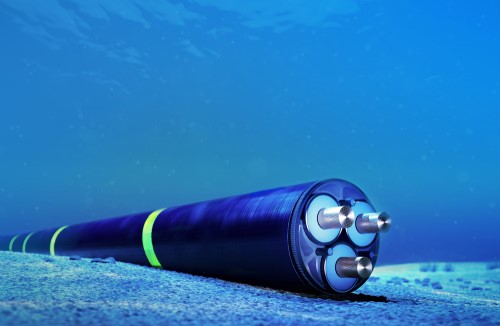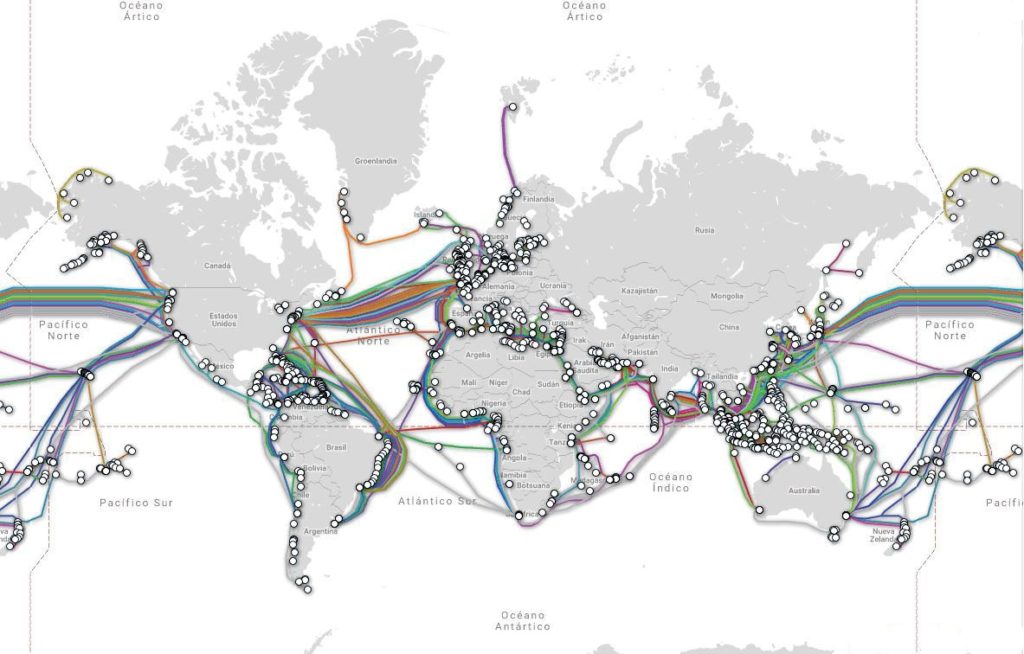Hundreds of submarine cables rest on the sea floor around the world, facilitating the constant connection of companies and boosting international trade. This is an essential resource for global business, as it allows the Internet to reach all corners of the planet, since wireless technology and satellite connections don’t have the same reliability and speed in data transmission. This improved performance is fostering the continuous spread of cables with private and public capital.
Humanity’s interest in being connected via submarine cable dates back to 1852, when a telecommunications network was laid between Great Britain and France through the English Channel to connect both countries to the telegraph network. It took another two years for the first transoceanic installation, thanks to Atlantic Telegraph Company, which placed a cable for telegraphic transmission between the Canadian island of Newfoundland and Ireland. Nevertheless, technical problems delayed the first stable transatlantic connection until 1866, and it was not until 1956 that a telephone line was installed.
Another milestone in the story was the appearance of fiber optics. According to Mariano Martínez and Noelia Miranda, member of the Board of Directors and head of Technical Development and Training at the Official Association of Telecommunications Engineers (COIT), respectively, modern submarine cables are made of optical fiber and based on the properties of pure fiberglass where light travels via internal reflection. “Due to light losing intensity throughout the cable, boosters are required at regular intervals to reestablish the intensity of the optical signal,” they said.
One of the greatest technical concerns is material durability in such an aggressive environment as the one underwater; cables are usually expected to last an average of 25 years. In order to ensure durability, the optical fibers are protected with a series of concentric layers that safeguard the interior. These layers are made of copper and polyethylene. They also have steel protection to be able to provide mechanical traction and resistance on the seabed. In the event that the cables are responsible for transporting electricity, they are also inserted in a special pipe to prevent the risk of contact with water.
In any case, once the source and destination of the cables have been defined, a bathymetric survey is carried out to design the route it will go through, i.e., “a 3D analysis of the ocean floor to determine the least turbulent path where the cable is least likely to be damaged.”
Cable security
Nevertheless, the ocean floor is not a flat surface, but rather a turbulent one with depressions, rocks, mountains, etc. That’s why fishing areas and faults are avoided when planning the cable’s final path and, wherever possible, boats unroll the cable over sandy floors instead of rocky ones. Other issues can arise from fishing boat and shipping accidents as well as the use of anchors. As Martínez and Miranda pointed out, sometimes the cables are even damaged by shark bites.
They must also be prepared for earthquakes. One occurring near Taiwan in 2006 (7.0 magnitude) broke eight cables and seriously affected communications in China. Today, movement sensors are placed on the ocean floor so that if the tremors begin there, the speed with which the cable can give a warning provides a great deal of leeway to anticipate situations in cities.
There are 378 submarine cables laid around the world, with a total length of 1.2 million kilometers
There are mechanisms to monitor the submarine cables and prevent the deteriorations caused by the fishing and shipping industries. The landing point (where the submarine cable makes landfall) plays a decisive role in guaranteeing proper functioning of the service in security protocols. The landing point, which works in conjunction with the Network Operations Center, has a series of technological tools to monitor the entire system in real time.
If the cable is damaged, repairs are done on the surface. “The damaged ends are retrieved by a submarine robot and the damage is then repaired, connected, or resolved on board special ships,” highlighted the COIT engineers.
In addition to the physical security of the cable, there are three international treaties that legally protect these lines. The most important laws notably include the freedom to lay, maintain, and repair submarine cables up to 12 nautical miles outside territorial waters and the national obligation to impose criminal and civil penalties on anyone who intentionally or negligently damages a cable.
International cooperation
Submarine cables mostly belong to large telecommunications firms. Some state and government-owned companies also have stakes in them and there are so-called consortium cables, which are the product of agreements between several companies such as Microsoft, Facebook, and Google.
There are several international projects. Google announced its intention to finance three new submarine cables that will connect five regions of the world. Next year, it will finance three submarine cable projects: Curie, a private cable that will connect Chile and Los Angeles; Havfrue, a consortium aiming to connect the US to Denmark and Ireland; and the Hong-Kong-Guam cable system, another consortium that will connect different underground communications centers throughout Asia.
 The installation of the first cable to directly connect Europe and South America is very significant, since up until now cables have gone to the United States and then connected to South America from there. The European Commission will provide 26.5 million euros, making it the largest investor in the Bella project – driven by a public-private partnership – which will involve laying 10,000 kilometers of cable under the Atlantic between Alentejo, Portugal, and Fortaleza, Brazil.
The installation of the first cable to directly connect Europe and South America is very significant, since up until now cables have gone to the United States and then connected to South America from there. The European Commission will provide 26.5 million euros, making it the largest investor in the Bella project – driven by a public-private partnership – which will involve laying 10,000 kilometers of cable under the Atlantic between Alentejo, Portugal, and Fortaleza, Brazil.
In Spain, most submarine cables start in the south, but another cable was recently rolled out in the north: Marea, a project driven by Telxius, Facebook, and Microsoft to connect Virginia Beach (east coast of the United States), where the largest concentration of data centers in the world is located, to Sopelana (Bizkaia) “thereby allowing two people separated by the Atlantic Ocean to communicate in less than one second.”
99% of transoceanic communications are done via submarine cables, which achieve speeds up to eight times faster than the satellite network
Future expansion
The great deal of interest from private companies and public institutions in these cables originates from the increase in connectivity across the planet. There are currently approximately 378 submarine cables laid around the world, with a total length of 1.2 million kilometers. The speed of development will increase in the short term. According to a Telegraphy report commissioned by DE-CIX, in the next three years there will be up to 74 systems more than 300,000 kilometers long, which are expected to have an estimated 8.8 billion dollar investment in the top submarine routes.
Their mission is fundamental since, according to Noelia Miranda and Mariano Martínez, although communications satellites cover part of the communications demand (especially for television and Internet), fiber optic submarine cables are the true Internet superhighways: “99% of transoceanic communications are done in this way, achieving speeds up to eight times faster than the satellite network,” they concluded.
One factor working in their favor is that they are not affected by atmospheric phenomena such as storms and cyclones, unlike satellites, and the path they cross is considerably shorter. For instance, the distance between Tokyo and Los Angeles is approximately 9,000 kilometers and a fiber optic cable will always give data a shorter path to travel than a satellite. This path will generally be above 36,000 kilometers, while Internet data carried via satellite has to go up to the satellite and then back down, doubling the journey (more than 72,000 kilometers).
Additionally, “in the future the evolution of technological equipment will allow us to double or quadruple capacity, as has occurred since older cables,” stated the COIT experts. This is essential, as data traffic in 2024 will have increased by 24%, according to Cisco. They advocate for greater development of oceanographic observatories to improve cable technology. However, both design and operations are continually evolving and new, smaller systems with greater capacity and reliability are being developed to cover all future communications needs.
Submarine cables around the world

Source: Submarine Cable Map, by TeleGeography (updated April 16, 2019)
This article was written with assistance from…
 Mariano Martínez Gómez holds a bachelor’s degree in Telecommunications Engineering from the Technical University of Madrid and an MBA from Complutense University of Madrid. He worked for several years at Fujitsu Spain and at the University of Málaga, although he has spent the majority of his career at Telefónica Móviles, working on the technical activities related to expanding the cellular network.
Mariano Martínez Gómez holds a bachelor’s degree in Telecommunications Engineering from the Technical University of Madrid and an MBA from Complutense University of Madrid. He worked for several years at Fujitsu Spain and at the University of Málaga, although he has spent the majority of his career at Telefónica Móviles, working on the technical activities related to expanding the cellular network.
In 2016, he joined Telxius Towers Spain, a company belonging to the Telefónica Group, where he holds the position of Assistant Engineering and Operations Director and actively works on launching the company in Spain and other Group operations such as Brazil. He is currently a member of the Board of Directors of COIT in Eastern Andalusia and Melilla and the Andalusian Association of Telecommunications Engineers (AITA).
 Noelia Miranda Santos received her bachelor’s degree in Telecommunications Engineering from the Technical University of Madrid. She is currently the head of Technical Development and Training for COIT.
Noelia Miranda Santos received her bachelor’s degree in Telecommunications Engineering from the Technical University of Madrid. She is currently the head of Technical Development and Training for COIT.
She has experience with the technological solutions used in telecommunications and aspects related to telecommunications economic and regulatory policy. She is a member of the Technical Secretariat of the Regulations and Public Policy Group at COIT and has been the institution’s representative at several telecommunications and ICT forums. She has worked on and co-authored several COIT publications, articles, and talks for journals, conferences, and workshops.
She has project management and coordination training, and notably develops new services and provides new professional opportunity analysis and exploration for telecommunications engineers.





